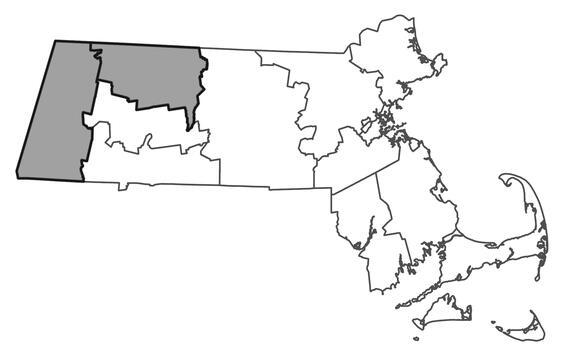- Scientific name: Polystichum braunii
- Species of Greatest Conservation Need (MA State Wildlife Action Plan)
- Endangered (MA Endangered Species Act)
Description
Braun’s holly-fern has dark green, glossy, leathery fronds that grow in vase-like clusters from stout rhizomes. It occurs on rich slopes of cool northern forests and is near its southern range limit in Massachusetts.
Leaves of Braun’s holly-fern may be up to 1 m (3.3 ft) long, including the grooved, densely scaly, 10 to 18 cm (4-7 in) stalk. The frond tapers toward each end and is twice pinnate: it is divided into 20 to 40 pairs of leaf-like pinnae, which in turn are divided into 6 to 18 pairs of pinnules. The pinnules are slightly serrate, with curved, bristle-tipped teeth, and there are long, hair-like scales on the veins. The round sori (spore-bearing structures) are in two rows on the undersides of the pinnules.
Intermediate woodfern (Dryopteris intermedia), like Braun’s holly-fern, is semi-evergreen, and it often occurs in the same habitats. However, the fronds are not leathery, do not taper toward the base, and lack the hair-like scales on the veins. The sori are not round, and the indusium (sorus covering) is attached laterally rather than with a central stalk as in Polystichum species.
Braun’s holly-fern sometimes hybridizes with the common Christmas fern (Polystichum acrostichoides) to form P. x potteri. At 1 mm wide, the indusia of this sterile hybrid are substantially wider than those of either of the parent species. This hybrid strongly resembles Braun’s holly-fern but relative to the pure species, the leafstalk is longer, the sori are closer together, the frond is more fully evergreen and tapers less dramatically toward the base, and the pinnae may be less fully divided into pinnules.
Life cycle and behavior
Since they are semi-evergreen, the fronds of Braun’s holly-fern can be seen all year round. New “fiddleheads” unfurl in the spring.
Population status
Braun’s holly-fern is listed under the Massachusetts Endangered Species Act as endangered. All listed species are protected from killing, collecting, possessing, or sale and from activities that would destroy habitat and thus directly or indirectly cause mortality or disrupt critical behaviors. The Massachusetts Natural Heritage & Endangered Species Program has 7 records from 2 counties: Berkshire and Franklin. Three of these records have been observed within the last 25 years.

Distribution in Massachusetts. 1999-2024. Based on records in the Natural Heritage Database.
Distribution and abundance
This species is circumboreal. In North America it occurs from Alaska to Nova Scotia, south to British Columbia in the west and to northern Minnesota and the mountains of Pennsylvania in the east.
Habitat
Throughout its range, Braun’s holly-fern is found in moist, usually circumneutral soil of cool northern hardwood–conifer forests. The known sites in Massachusetts include the margins of cold mountain brooks; steep, rocky ravines and hillsides; a rich, mesic forest; and talus at the base of a cliff.
Bristly black currant (Ribes lacustre), a state species of special concern, has been noted several times as co-occurring. Braun’s holly-fern has also been found growing with indicators of calcium-rich rock such as fragile rock-brake (Cryptogramma stelleri; threatened in MA) and broad waterleaf (Hydrophyllum canadense; endangered in MA). An individual found on a slope without calcareous indicators was determined to be the hybrid, P. x potteri.
Healthy habitats are vital for supporting native wildlife and plants. Explore habitats and learn about conservation and restoration in Massachusetts.
Threats
Near its southern range limit in Massachusetts, the greatest threat to Braun’s holly-fern may be climate change. Logging and other human-caused disturbances or habitat alterations are also of concern since this species appears to require heavy canopy cover.
Conservation
All active management of rare plant populations (including invasive species removal) is subject to review under the Massachusetts Endangered Species Act and should be planned in close consultation with the MassWildlife’s Natural Heritage & Endangered Species Program.
Contact
| Date published: | May 5, 2025 |
|---|